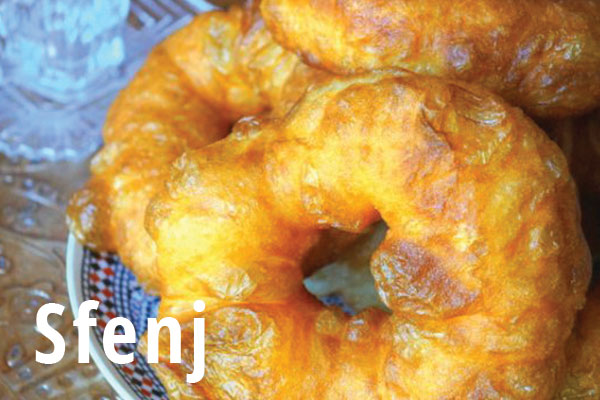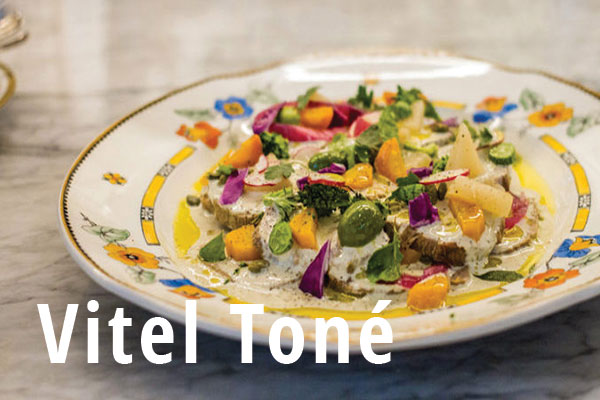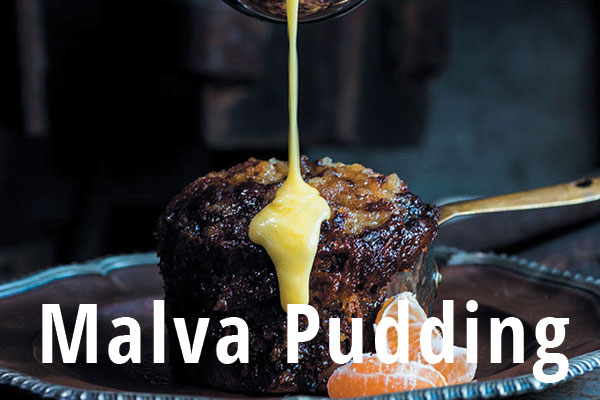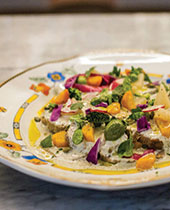Treat your guests this holiday with some international favourites from Morocco, Argentina and South Africa! With my own gatherings with family and friends in mind, I've scoured the internet for recipes that are sure to impress.

Sfenj are swoon-worthy Moroccan beignets. Though they are available in markets year round, their popularity skyrockets around Hanukkah time. Little sister to traditional sufganiyot (fried jelly doughnuts) sfenj are even easier to make.
INGREDIENTS:
500g flour
10g of dried baker's yeast or fresh 25 g
10g salt
10g sugar
15g powdered milk
1 egg
10g baking powder
350g warm water
Sunflower oil for frying
DIRECTIONS: In the bowl mixer, or in a large bowl add baker's yeast, sugar, warm water and all of the flour except 1 tablespoon. Mix well into a ball, then cover with plastic wrap. Once the yeast has doubled the dough ball's size, add the remaining flour, milk powder and salt and start kneading. Mix the beaten egg with baking powder while continuing mixing for about 10 minutes. Cover dough until it has doubled in size again. Cut the dough into small pieces and form each one into a doughnut shape. Heat the sunflower oil in a shallow skillet and cook each side of the doughnut until golden brown. Place on plate lined with paper towel to cool. Serve warm with honey and sprinkled with sugar. Swoon!

No Argentinian Christmas is complete without Vitel Toné, an extraordinary adaptation of Italy's Vitello Tonnato. This traditional dish is served cold—December can be very warm!
INGREDIENTS:
Veal
1 veal eye of round, about 3 lb
¼ cup olive oil
1 large white onion, sliced, 2.5cm rings
1 large carrot, peeled, 2.5 cm lengths
1 medium white turnip, 2.5cm slices
1 small head celeriac, cubed, about 2.5cm
2 cloves, crushed
1/2 bottle white wine
4 bay leaves
1 large sprig oregano
2 cups chicken stock
Salt, pepper
1 veal eye of round, about 3 lb
¼ cup olive oil
1 large white onion, sliced, 2.5cm rings
1 large carrot, peeled, 2.5 cm lengths
1 medium white turnip, 2.5cm slices
1 small head celeriac, cubed, about 2.5cm
2 cloves, crushed
1/2 bottle white wine
4 bay leaves
1 large sprig oregano
2 cups chicken stock
Salt, pepper
Sauce
2/3 cup mayo
¼ cup drained, olive oil-packed, flaked tuna
2 soft-boiled eggs
10 anchovy fillets, drained
2 tbsp capers
2 tbsp lemon juice
1 clove garlic, chopped
½ tsp ground aji amarillo (or cayenne pepper)
1/3 cup olive oil
Salt, pepper
DIRECTIONS:
2/3 cup mayo
¼ cup drained, olive oil-packed, flaked tuna
2 soft-boiled eggs
10 anchovy fillets, drained
2 tbsp capers
2 tbsp lemon juice
1 clove garlic, chopped
½ tsp ground aji amarillo (or cayenne pepper)
1/3 cup olive oil
Salt, pepper
DIRECTIONS:
Preheat oven to 250°F. Season the veal liberally with the salt and pepper. Rest on countertop for 30 minutes before cooking. Heat a heavy-bottomed Dutch oven on medium-high, add half the oil, and when it shimmers, sear the veal until bronzed (do not blacken) on all sides. Set aside on countertop. Lower heat to medium, add half remaining oil (1 tbsp) along with the onion, carrot, turnip, celeriac and garlic. Sauté until lightly browned—about 7 minutes. Add the bay leaf and oregano, season lightly. Set aside on countertop. Lower heat to medium, add half remaining oil (1 tbsp) along with the onion, carrot, turnip, celeriac and garlic. Sauté until lightly browned—about 7 minutes. Add the bay leaf and oregano, season lightly, raise heat and deglaze with the wine. Reduce by three-quarters, then add the stock. When it boils lower heat to a simmer, add veal and its juices, and sprinkle with remaining olive oil. Taste braising liquid and adjust seasoning. Cover pot tightly with aluminum foil, then its lid, and transfer to the oven. After an hour or so, rotate pot. Cook until veal is tender and cooked throughout.
Season the veal liberally with the salt and pepper. Rest on countertop for 30 minutes before cooking. Heat a heavy-bottomed Dutch oven on medium-high, add half the oil, and when it shimmers, sear the veal until bronzed (do not blacken) on all sides. Set aside on countertop. Lower heat to medium, add half remaining oil (1 tbsp) along with the onion, carrot, turnip, celeriac and garlic. Sauté until lightly browned—about 7 minutes. Add the bay leaf and oregano, season lightly. Add the bay leaf and oregano, season lightly, raise heat and deglaze with the wine. Reduce by three-quarters, then add the stock. When it boils lower heat to a simmer, add veal and its juices, and sprinkle with remaining olive oil. Taste braising liquid and adjust seasoning. Cover pot tightly with aluminum foil, then its lid, and transfer to the oven. After an hour or so, rotate pot. Cook until veal is tender and its internal temperature has reached 60-65°C. With a slotted spoon remove vegetables (reserve) and herbs (discard). Allow veal to cool in its braising liquid, then transfer pot to refrigerator to chill—4-6 hours. Slice vegetables, cover and set aside in refrigerator In a blender, combine mayonnaise, tuna, eggs, anchovies, capers, lemon juice, garlic, aji, 2 tbsp of the veal braising liquid and a generous dash of salt and pepper. Blend until smooth. If mixture seems too thick, add another tbsp of braising liquid. Once smooth, blend in the olive oil. Taste, and adjust seasonings.
To finish, slice veal 0.5 cm (¼”) thick. Cover base of serving platter with a thin layer of tuna sauce. Arrange veal slices on top, and follow with the rest of the sauce. Scatter reserved vegetables on top. Cover with plastic wrap and refrigerate for 1 hour, minimum.
Season the veal liberally with the salt and pepper. Rest on countertop for 30 minutes before cooking. Heat a heavy-bottomed Dutch oven on medium-high, add half the oil, and when it shimmers, sear the veal until bronzed (do not blacken) on all sides. Set aside on countertop. Lower heat to medium, add half remaining oil (1 tbsp) along with the onion, carrot, turnip, celeriac and garlic. Sauté until lightly browned—about 7 minutes. Add the bay leaf and oregano, season lightly. Add the bay leaf and oregano, season lightly, raise heat and deglaze with the wine. Reduce by three-quarters, then add the stock. When it boils lower heat to a simmer, add veal and its juices, and sprinkle with remaining olive oil. Taste braising liquid and adjust seasoning. Cover pot tightly with aluminum foil, then its lid, and transfer to the oven. After an hour or so, rotate pot. Cook until veal is tender and its internal temperature has reached 60-65°C. With a slotted spoon remove vegetables (reserve) and herbs (discard). Allow veal to cool in its braising liquid, then transfer pot to refrigerator to chill—4-6 hours. Slice vegetables, cover and set aside in refrigerator In a blender, combine mayonnaise, tuna, eggs, anchovies, capers, lemon juice, garlic, aji, 2 tbsp of the veal braising liquid and a generous dash of salt and pepper. Blend until smooth. If mixture seems too thick, add another tbsp of braising liquid. Once smooth, blend in the olive oil. Taste, and adjust seasonings.
To finish, slice veal 0.5 cm (¼”) thick. Cover base of serving platter with a thin layer of tuna sauce. Arrange veal slices on top, and follow with the rest of the sauce. Scatter reserved vegetables on top. Cover with plastic wrap and refrigerate for 1 hour, minimum.

Malva pudding is close to the hearts of many South Africans. Below is the ultimate malva pudding—moist and dense, it’s heart-wrenchingly delicious with a lovely, subtle naartjie (orange) tang. Best served with simple homemade pouring custard.
INGREDIENTS:
125g butter
1 egg
130g sugar
1 tsp vinegar/lemon juice
90g apricot jam
1 tsp soda
80g cake flour
1 cup milk
1 tbsp naartjie/orange rind
small pinch salt
Citrus Custard
2 cups milk
1 tsp naartjie/orange rind (optional)
5 egg yolks
2 tbsp castor sugar
1 tsp cake flour
drop vanilla extract
Syrup
½ cup fresh cream
65g sugar
60g butter
65ml naartjie/orange juice
DIRECTIONS: Preheat the oven to 180˚C. Cream together the 125g butter, the egg and 130g sugar in a mixing bowl. Add the vinegar or lemon juice, apricot jam and bicarbonate of soda and mix to combine. Add the 80g cake flour, 250ml (1 cup) milk, citrus rind and salt and mix to combine. Pour into a prepared 20cm-square baking tin and bake in the oven, 25 – 30 minutes.
For the custard, heat the 500ml (2 cups) milk in a pot to almost boiling point – make sure it doesn’t boil. Just as you take it off the heat, add the naartjie rind, if desired. Set aside.
Meanwhile, in a bowl, beat the egg yolks with the castor sugar and 5ml (1 tsp) cake flour until pale and smooth. Pour the milk over the egg mixture, very slowly at first, whisking well to incorporate. Return the mixture to the milk pan and reheat it very gently, stirring all the time (a wooden spoon or spatula is best). As soon as the mixture begins to coat the back of the spoon, rather than just looking like hot milk, the custard is ready. It should be the consistency of cream, so not very thick.
For the syrup, heat all of the ingredients in a small pot over low heat, 10 minutes.
Remove the pudding from the oven and slowly pour over the syrup. Serve warm with the custard. Mmmmm.
1 egg
130g sugar
1 tsp vinegar/lemon juice
90g apricot jam
1 tsp soda
80g cake flour
1 cup milk
1 tbsp naartjie/orange rind
small pinch salt
Citrus Custard
2 cups milk
1 tsp naartjie/orange rind (optional)
5 egg yolks
2 tbsp castor sugar
1 tsp cake flour
drop vanilla extract
Syrup
½ cup fresh cream
65g sugar
60g butter
65ml naartjie/orange juice
DIRECTIONS: Preheat the oven to 180˚C. Cream together the 125g butter, the egg and 130g sugar in a mixing bowl. Add the vinegar or lemon juice, apricot jam and bicarbonate of soda and mix to combine. Add the 80g cake flour, 250ml (1 cup) milk, citrus rind and salt and mix to combine. Pour into a prepared 20cm-square baking tin and bake in the oven, 25 – 30 minutes.
For the custard, heat the 500ml (2 cups) milk in a pot to almost boiling point – make sure it doesn’t boil. Just as you take it off the heat, add the naartjie rind, if desired. Set aside.
Meanwhile, in a bowl, beat the egg yolks with the castor sugar and 5ml (1 tsp) cake flour until pale and smooth. Pour the milk over the egg mixture, very slowly at first, whisking well to incorporate. Return the mixture to the milk pan and reheat it very gently, stirring all the time (a wooden spoon or spatula is best). As soon as the mixture begins to coat the back of the spoon, rather than just looking like hot milk, the custard is ready. It should be the consistency of cream, so not very thick.
For the syrup, heat all of the ingredients in a small pot over low heat, 10 minutes.
Remove the pudding from the oven and slowly pour over the syrup. Serve warm with the custard. Mmmmm.



